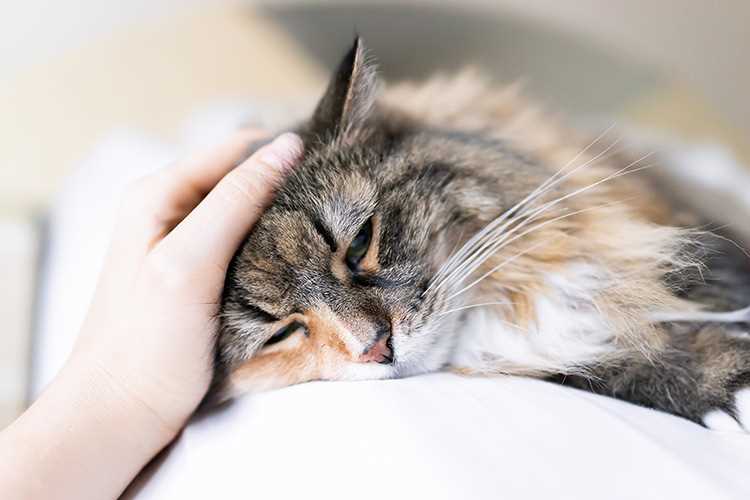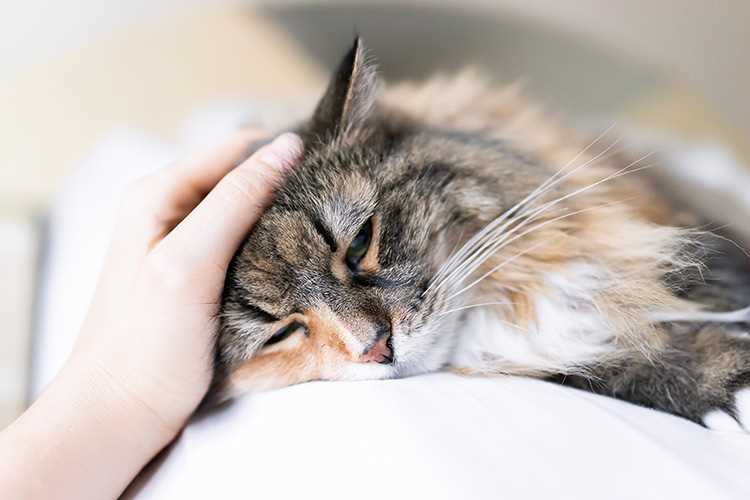



When the spark in your feline’s eyes dims, it may be an indicator that a tough choice lies ahead. Look for behavioral changes such as withdrawal from play, a noticeable decrease in appetite, or reluctance to engage with familiar surroundings. These signs can reflect discomfort or suffering that could point to underlying health issues.
Physical symptoms like persistent vomiting, difficulty breathing, or significant weight loss warrant immediate attention. If your furry companion struggles to perform daily activities, such as grooming or using the litter box, this could signal that their quality of life has diminished. Regular check-ups can help identify health problems early, but observing these changes is equally crucial.
Consulting with a veterinarian is essential when these signs arise. They can provide insights and help evaluate overall health. Discussing options with them can guide you through this challenging moment. Remember, prioritizing comfort and well-being is key. A loving decision may sometimes mean letting go for the sake of your cherished friend.
Recognizing the Right Moment
Persistent signs of pain or discomfort, such as difficulty moving or reluctance to engage in favorite activities, indicate that a decision may be necessary. If my appetite has significantly decreased or I refuse to eat altogether, it suggests a decline in my quality of life.
Unusual behaviors like hiding, excessive vocalization, or aggression can also signal distress. Changes in litter box habits, including incontinence or straining, should not be overlooked. These shifts often mean I am struggling.
Consulting with a trusted veterinarian is crucial. They can assess my condition and provide insights into my overall health. Discussions about pain management and comfort levels are essential to determine the best path forward.
When my days are filled with more discomfort than joy, and I can no longer enjoy simple pleasures, it may be the right moment to consider what’s best for me. Prioritizing quality of life over longevity is a compassionate choice. It’s about ensuring I am free from suffering.
Recognizing the Signs of Severe Pain and Distress

Pay attention to changes in behavior. If I suddenly become withdrawn or avoid my favorite spots, it might indicate discomfort. A decrease in grooming habits, leading to a scruffy appearance, is another red flag. If I stop eating or drinking, even for a short period, it’s a sign that something is wrong.
Vocalization can also reveal my state. Unusual cries, growls, or constant meowing may suggest I’m in pain. Watch for changes in my posture; a hunched back or reluctance to move can signal distress. If I flinch when touched or seem overly sensitive to handling, these reactions are significant indicators of suffering.
Physical Symptoms to Monitor
Keep an eye out for any limping or difficulty in movement. If I struggle to jump or play, it could be due to joint pain or other physical ailments. Changes in my breathing–rapid or labored–should not be ignored, as they often indicate serious issues. Notice any signs of excessive panting or coughing as well.
Changes in Elimination Habits
Observe my litter box behavior. If I have accidents outside the box or seem to strain while trying to relieve myself, this could be a sign of pain or illness. Blood in urine or feces is especially concerning and requires immediate attention.
Evaluating Quality of Life and Daily Functioning

Assessing daily activities provides crucial insights into well-being. Track these aspects to gauge overall condition:
Physical Activity

- Observe mobility: Is there difficulty in walking or jumping?
- Monitor playfulness: Does engaging in favorite toys occur regularly?
- Check for grooming habits: Is self-grooming consistent or neglected?
Eating and Drinking Habits

- Notice appetite changes: Is there a drastic decrease in food intake?
- Examine water consumption: Are hydration levels adequate?
- Look for signs of nausea or discomfort after eating.
Consider emotional well-being too. Social interactions are key:
- Evaluate desire for companionship: Is there a need for affection or solitude?
- Check responses to favorite activities or family members.
Environmental factors impact quality of life. Ensure comfort in living space, including adequate room for movement. For more details on space requirements, check how much space do cats need.
Health management also plays a role. Regular veterinary check-ups can identify issues early. If there are concerns about health supplements, learn about appropriate dosages at how much diatomaceous earth for cats.
Collecting this data will help determine overall happiness and comfort, allowing for informed decisions regarding care and support.
When the spark in your feline’s eyes dims, it may be an indicator that a tough choice lies ahead. Look for behavioral changes such as withdrawal from play, a noticeable decrease in appetite, or reluctance to engage with familiar surroundings. These signs can reflect discomfort or suffering that could point to underlying health issues.
Physical symptoms like persistent vomiting, difficulty breathing, or significant weight loss warrant immediate attention. If your furry companion struggles to perform daily activities, such as grooming or using the litter box, this could signal that their quality of life has diminished. Regular check-ups can help identify health problems early, but observing these changes is equally crucial.
Consulting with a veterinarian is essential when these signs arise. They can provide insights and help evaluate overall health. Discussing options with them can guide you through this challenging moment. Remember, prioritizing comfort and well-being is key. A loving decision may sometimes mean letting go for the sake of your cherished friend.
Recognizing the Right Moment
Persistent signs of pain or discomfort, such as difficulty moving or reluctance to engage in favorite activities, indicate that a decision may be necessary. If my appetite has significantly decreased or I refuse to eat altogether, it suggests a decline in my quality of life.
Unusual behaviors like hiding, excessive vocalization, or aggression can also signal distress. Changes in litter box habits, including incontinence or straining, should not be overlooked. These shifts often mean I am struggling.
Consulting with a trusted veterinarian is crucial. They can assess my condition and provide insights into my overall health. Discussions about pain management and comfort levels are essential to determine the best path forward.
When my days are filled with more discomfort than joy, and I can no longer enjoy simple pleasures, it may be the right moment to consider what’s best for me. Prioritizing quality of life over longevity is a compassionate choice. It’s about ensuring I am free from suffering.
Recognizing the Signs of Severe Pain and Distress

Pay attention to changes in behavior. If I suddenly become withdrawn or avoid my favorite spots, it might indicate discomfort. A decrease in grooming habits, leading to a scruffy appearance, is another red flag. If I stop eating or drinking, even for a short period, it’s a sign that something is wrong.
Vocalization can also reveal my state. Unusual cries, growls, or constant meowing may suggest I’m in pain. Watch for changes in my posture; a hunched back or reluctance to move can signal distress. If I flinch when touched or seem overly sensitive to handling, these reactions are significant indicators of suffering.
Physical Symptoms to Monitor
Keep an eye out for any limping or difficulty in movement. If I struggle to jump or play, it could be due to joint pain or other physical ailments. Changes in my breathing–rapid or labored–should not be ignored, as they often indicate serious issues. Notice any signs of excessive panting or coughing as well.
Changes in Elimination Habits
Observe my litter box behavior. If I have accidents outside the box or seem to strain while trying to relieve myself, this could be a sign of pain or illness. Blood in urine or feces is especially concerning and requires immediate attention.
Evaluating Quality of Life and Daily Functioning

Assessing daily activities provides crucial insights into well-being. Track these aspects to gauge overall condition:
Physical Activity

- Observe mobility: Is there difficulty in walking or jumping?
- Monitor playfulness: Does engaging in favorite toys occur regularly?
- Check for grooming habits: Is self-grooming consistent or neglected?
Eating and Drinking Habits

- Notice appetite changes: Is there a drastic decrease in food intake?
- Examine water consumption: Are hydration levels adequate?
- Look for signs of nausea or discomfort after eating.
Consider emotional well-being too. Social interactions are key:
- Evaluate desire for companionship: Is there a need for affection or solitude?
- Check responses to favorite activities or family members.
Environmental factors impact quality of life. Ensure comfort in living space, including adequate room for movement. For more details on space requirements, check how much space do cats need.
Health management also plays a role. Regular veterinary check-ups can identify issues early. If there are concerns about health supplements, learn about appropriate dosages at how much diatomaceous earth for cats.
Collecting this data will help determine overall happiness and comfort, allowing for informed decisions regarding care and support.
When the spark in your feline’s eyes dims, it may be an indicator that a tough choice lies ahead. Look for behavioral changes such as withdrawal from play, a noticeable decrease in appetite, or reluctance to engage with familiar surroundings. These signs can reflect discomfort or suffering that could point to underlying health issues.
Physical symptoms like persistent vomiting, difficulty breathing, or significant weight loss warrant immediate attention. If your furry companion struggles to perform daily activities, such as grooming or using the litter box, this could signal that their quality of life has diminished. Regular check-ups can help identify health problems early, but observing these changes is equally crucial.
Consulting with a veterinarian is essential when these signs arise. They can provide insights and help evaluate overall health. Discussing options with them can guide you through this challenging moment. Remember, prioritizing comfort and well-being is key. A loving decision may sometimes mean letting go for the sake of your cherished friend.
Recognizing the Right Moment
Persistent signs of pain or discomfort, such as difficulty moving or reluctance to engage in favorite activities, indicate that a decision may be necessary. If my appetite has significantly decreased or I refuse to eat altogether, it suggests a decline in my quality of life.
Unusual behaviors like hiding, excessive vocalization, or aggression can also signal distress. Changes in litter box habits, including incontinence or straining, should not be overlooked. These shifts often mean I am struggling.
Consulting with a trusted veterinarian is crucial. They can assess my condition and provide insights into my overall health. Discussions about pain management and comfort levels are essential to determine the best path forward.
When my days are filled with more discomfort than joy, and I can no longer enjoy simple pleasures, it may be the right moment to consider what’s best for me. Prioritizing quality of life over longevity is a compassionate choice. It’s about ensuring I am free from suffering.
Recognizing the Signs of Severe Pain and Distress

Pay attention to changes in behavior. If I suddenly become withdrawn or avoid my favorite spots, it might indicate discomfort. A decrease in grooming habits, leading to a scruffy appearance, is another red flag. If I stop eating or drinking, even for a short period, it’s a sign that something is wrong.
Vocalization can also reveal my state. Unusual cries, growls, or constant meowing may suggest I’m in pain. Watch for changes in my posture; a hunched back or reluctance to move can signal distress. If I flinch when touched or seem overly sensitive to handling, these reactions are significant indicators of suffering.
Physical Symptoms to Monitor
Keep an eye out for any limping or difficulty in movement. If I struggle to jump or play, it could be due to joint pain or other physical ailments. Changes in my breathing–rapid or labored–should not be ignored, as they often indicate serious issues. Notice any signs of excessive panting or coughing as well.
Changes in Elimination Habits
Observe my litter box behavior. If I have accidents outside the box or seem to strain while trying to relieve myself, this could be a sign of pain or illness. Blood in urine or feces is especially concerning and requires immediate attention.
Evaluating Quality of Life and Daily Functioning

Assessing daily activities provides crucial insights into well-being. Track these aspects to gauge overall condition:
Physical Activity

- Observe mobility: Is there difficulty in walking or jumping?
- Monitor playfulness: Does engaging in favorite toys occur regularly?
- Check for grooming habits: Is self-grooming consistent or neglected?
Eating and Drinking Habits

- Notice appetite changes: Is there a drastic decrease in food intake?
- Examine water consumption: Are hydration levels adequate?
- Look for signs of nausea or discomfort after eating.
Consider emotional well-being too. Social interactions are key:
- Evaluate desire for companionship: Is there a need for affection or solitude?
- Check responses to favorite activities or family members.
Environmental factors impact quality of life. Ensure comfort in living space, including adequate room for movement. For more details on space requirements, check how much space do cats need.
Health management also plays a role. Regular veterinary check-ups can identify issues early. If there are concerns about health supplements, learn about appropriate dosages at how much diatomaceous earth for cats.
Collecting this data will help determine overall happiness and comfort, allowing for informed decisions regarding care and support.








